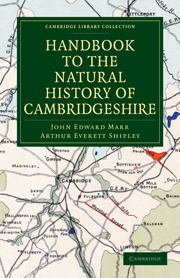Appendix to the Article on the Mollusca
Published online by Cambridge University Press: 10 November 2010
Summary
Since going to press the writer is indebted to Mrs Hughes for the following additional localities and notes on living forms from her own observations.
Neritina fluviatilis; Hauxton Mill, Ditton.
Vieipara vivipara; the record on p. 123 is based on a single specimen in Wisbech Museum, which is possibly a young V. contecta.
Limnaea truncatula; Wisbech Canal (brackish water), River Nene, Roslyn Pit at Ely.
Planorbis crista; White House Drove near Littleport, March.
Vitrea rogersi; fairly common, Cambridge, Harston, Hauxton.
V. radiatula; Hauxton Mill.
Zonitoides excavatus; Madingley, March.
Euconulus fulvus; Grantchester, Madingley, etc.
Sphyradium edentulum; Roman Road on the Gogmagog.
Hygromia granulata; Hauxton, Whittlesford, Waterbeach.
Acanthinula aculeata; found again recently in Madingley Wood by Mrs Hughes and Mr Laidlaw (see p. 121).
Vallonia pulchella; Thorney, Cherryhinton, but less common than V. costata, which is found all over the county (see p. 122).
Helicigona lapicida; alive at Fen Ditton (see p. 130); seems dying out.
Helix hortensis; not common, but occurs at Fen Ditton, Haslingfield, Fulbourn, Cherryhinton and March.
Ena obscura; fairly common in and about Cambridge.
Caecilioides acicula; in holes in gravel, Cambridge Station, the Observatory, and alive at Hauxton (see p. 121).
Jaminia cylindracea; Bracondale (Cambridge), Babraham, Hauxton, Baitsbite, Duxford.
Vertigo pygmaea; Roman Road on the Gogmagog.
Balea perversa; on willows along Bourne Brook and on elms N.W. of March.
Clausilia laminata; Madingley, Haslingfield, Cherryhinton, Fen Ditton.
- Type
- Chapter
- Information
- Handbook to the Natural History of Cambridgeshire , pp. 257 - 258Publisher: Cambridge University PressPrint publication year: 2010First published in: 1904

